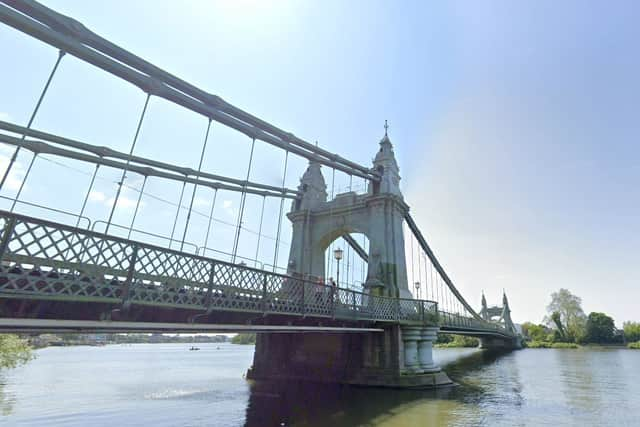Hammersmith Bridge to reopen temporarily to cyclists
and live on Freeview channel 276
Hammersmith Bridge will temporarily re-open to cyclists from next week for a period of around 10 weeks.
Hammersmith & Fulham council has installed a new two-way cycle lane on the Grade-II* listed structure, enabling those on bikes to cross without having to dismount from Tuesday February 13.
Advertisement
Hide AdAdvertisement
Hide AdCargo bikes and e-scooters will also be permitted access, though motorbikes and mopeds have to continue using alternative routes.
Motor vehicles have been unable to use the bridge since 2019, after micro-fractures were identified in its pedestals.
It was partially reopened to pedestrians and cyclists in 2021, though since then, repairs have stalled due to disputes over the funding.


The Department for Transport (DfT) wants the council and Transport for London (TfL) to pay a third of the bill each, now estimated at £250 million, with the Government to pick up the rest.
Advertisement
Hide AdAdvertisement
Hide AdHammersmith & Fulham submitted a business case with the government last year, which is yet to be approved.
The council said it had expected this to be agreed before Christmas, though the DfT said it is still reviewing it to “ensure it is viable and offers value for money for taxpayers”.
The temporary cycle lane is being installed after a boat ferrying West Ham football fans towards Fulham FC’s Craven Cottage stadium damaged the bridge in December.
The council said that stabilisation works had to be paused as a result, and so while it is carrying out repairs, it is taking the opportunity to roll out the cycle lane.
Advertisement
Hide AdAdvertisement
Hide AdCllr Sharon Holder, Hammersmith and Fulham Cabinet Member for the Public Realm, said: “Hammersmith Bridge is a major regional transport asset that will cost a massive £250m to repair. This is a national and a London issue with most users of the bridge coming from south London and the A3 corridor. Fixing this historic bridge requires the support of both the national and regional Government.
“We are committed to the full re-opening of Hammersmith Bridge to motor vehicles including buses, and we are doing all in our powers to deliver on that commitment. But we are a small local authority, and we must have the financial support of the DfT and Transport for London, as well as an agreement to fund our share via a toll.”
On the suggestion it is holding up proceedings due to having not approved the council’s business case, a DfT spokesperson said: “This claim is simply not true, we have already given nearly £10m to help restore the bridge and are reviewing the business case to ensure it is viable and offers value for money for taxpayers.”
A TfL spokesperson said: “We are supporting the London Borough of Hammersmith & Fulham in plans to fully reopen Hammersmith Bridge to traffic. The bridge is an important transport link and we continue to raise the reinstatement of bus links across the river in discussions with the Department for Transport and the borough. The borough’s business case is currently with the DfT for approval and we will support the borough in progressing their next steps.”
Advertisement
Hide AdAdvertisement
Hide AdJakub Mamczak, Senior Campaigns Officer at London Cycling Campaign, said: “We massively welcome the new cycle lane across Hammersmith Bridge. This will connect communities on both sides of the bridge.
“Walking with a cycle isn’t possible for some who use their cycle as a mobility aid and can be difficult with cargo cycles. This should be part of a long term solution for the bridge, along with ideas such as using light vehicles to replace buses, rather than opening the bridge to private motor vehicles.”
The council has said the last stage of the stabilisation works involve jacking up the four corner pedestals. Following that, it will review e-mobility options for the bridge, such as for transporting the elderly or disabled, subject to a 1.5-tonne weight limit.
Comment Guidelines
National World encourages reader discussion on our stories. User feedback, insights and back-and-forth exchanges add a rich layer of context to reporting. Please review our Community Guidelines before commenting.
